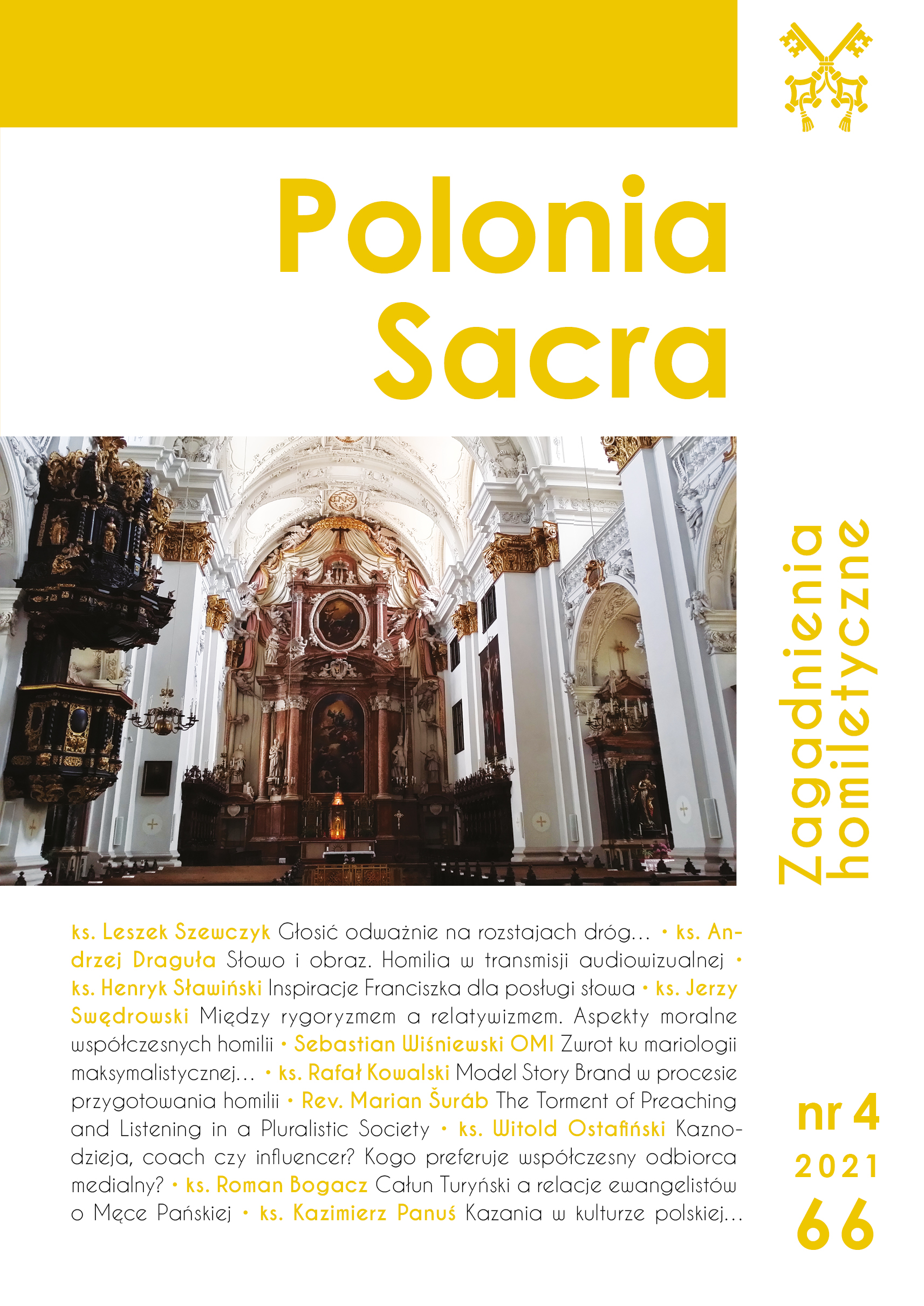Słowo i obraz. Homilia w transmisji audiowizualnej
DOI:
https://doi.org/10.15633/ps.4135Słowa kluczowe:
kaznodziejstwo radiowe, kaznodziejstwo telewizyjne, transmisja Mszy św., mass media, homiliaAbstrakt
Artykuł podejmuje problem wpływu czynnika technologicznego na percepcję homilii głoszonej podczas Mszy św. transmitowanej w radiu, telewizji czy też za pomocą streamingu internetowego. Przepowiadanie słowa Bożego jest poddane tym samym prawom, co inne transmisje live. Homilia słuchana w radiu pozbawiona jest warstwy wizualnej, a homilia transmitowana w telewizji oraz Internecie dociera do odbiorcy w wersji wizualnej zmontowanej przez reżysera obrazu. Obie formy różnią się od homilii wysłuchiwanej i oglądanej na żywo w kościele. Percepcja uwarunkowana medium, za pośrednictwem którego dokonuje się transmisja, warunkuje recepcję treści kazania. I choć skuteczność nadprzyrodzona słowa Bożego nie jest deterministycznie powiązana ze skutecznością komunikacyjną czy retoryczną, medialne pośredniczenie w odbiorze kazania nie pozostaje bez wpływu na jego skuteczność.
Bibliografia
Draguła A., Eucharystia zmediatyzowana. Teologiczno-pastoralna interpretacja Mszy Świętej w radiu i telewizji, Zielona Góra 2009.
Drzewiecki P., Audytywność radia a zasada fides ex auditu w radiowym przekazie wiary chrześcijańskiej (mps), Warszawa 2002.
Henau E., Televisione, w: Dizionario di omiletica, a cura M. Sodi, A.M. Triacca, Torino–Bergamo 1998, s. 1338–1343.
Jachimowski T., Kaznodziejstwo radjowe, „Przegląd Homiletyczny” 13 (1935) nr 3, s. 220–231.
Japola J., Tekst czy głos? Waltera J. Onga antropologia literatury, Lublin 1988.
Kopiec J. bp, Dyspensa od obowiązku niedzielnego uczestnictwa we Mszy świętej z dn. 12 marca 2020 r., Nr 331/20/A, https://anna.zabrze.pl/wp-content/uploads/2018/05/Dyspensa-od-obowi%C4%85zku-uczestniczenia-we-Mszy-%C5%9Bw.-niedzielnej.pdf (20.03.2020).
Krynicki W., Wymowa święta, czyli podręcznik do teorji kaznodziejstwa, Poznań–Warszawa 1921.
Manovich L., Ku archeologii ekranu komputerowego, tłum. A. Piskorz, w: Widzieć, myśleć, być. Technologie mediów, oprac. A. Gwóźdź, Kraków 2001, s. 167–190.
Marcyński K., Komunikacja religijna i media, Kraków 2016.
Massa W., Kirchliche Rede in den Massenmedien: Formen technisch vermittelter persönlicher Anschprache, w: Handbuch der Verkündigung, Bd. 2, Hrsg. B. Dreher [i in.], Freiburg–Basel–Wien 1970, s. 278–310.
McLuhan M., Zrozumieć media. Przedłużenia człowieka, tłum. N. Szczucka, Warszawa 2004.
Mugerli G., Radio, w: Dizionario di Omiletica, a cura M. Sodi, A.M. Triacca, Torino–Bergamo 1998, s. 1314–1319.
Ogonowska A., Ekran, „Nowa Polszczyzna” (2005) nr 5, s. 43–47.
Ong W., Oralność i piśmienność. Słowo poddane technologii, tłum. J. Japola, Lublin 1992.
Plis J., Kościół katolicki w Polsce a prasa, radio i film (1918–1939), Lublin 2001.
Popowicz E. abp, Juszczak W.R. bp, List biskupów greckokatolickich w sprawie epidemii koronawirusa w Polsce, Przemyśl–Wrocław, 15.03.2020, https://episkopat.pl/biskupi-greckokatoliccy-w-polsce-udzielili-dyspensy-i-poprosili-o-modlitwe-w-domach-2/ (20.04.2021).
Porczak A., Ekran – pole transakcji, w: Wiek ekranów. Przestrzenie kultury widzenia, red. A. Gwóźdź, P. Zawojski, Kraków 2002, s. 45–52.
Rogé R., Image et exclusion. Réflexion sur une définition de Roland Barthes, „Communio” (wersja franc.) (2004) n. 29, s. 105–116.
Schultze Q.J., Televison and Preaching, w: Concise Encyclopedia of Preaching, eds. W.H. Willimon, R. Lischer, Louisville 1995, s. 469–476.
Seveso B., Diffidenza o accoglienza? Il controverso punto di vista dei teologi, w: La Chiesa e i media, a cura G. Angelini, Milano 1996, s. 108–150.
Szczepaniak M., Msza fonogeniczna. Pierwsza polska radiowa transmisja mszy świętej i towarzyszące jej okoliczności, Poznań 2013.
Weber S., Telewizja: odbiornik i ekran, tłum. E. Stawowczyk, w: Widzieć, myśleć, być. Technologie mediów, oprac. A. Gwóźdź, Kraków 2001, s. 381–398.
Weber T.P., Radio Preaching, w: Concise Encyclopedia of Preaching, eds. W.H. Willimon, R. Lischer, Louisville 1995, s. 397–400.
Pobrania
Opublikowane
Numer
Dział
Licencja
Autorzy publikujący w czasopiśmie udzielają jego wydawcy zgody o następującej treści:
- Autor zachowuje autorskie prawa majątkowe do utworu, a jednocześnie udziela wydawcy czasopisma zgody na jego pierwszą publikację w wersji drukowanej i wersji online na licencji Creative Commons Uznanie autorstwa 4.0 Międzynarodowe oraz zgody na wykonywanie opracowań, w tym przekładów.
- Autor ma możliwość udzielania zgody niewyłącznej na opublikowanie utworu w wersji, która ukazała się w czasopiśmie (np. zamieszczenia go w repozytorium instytucjonalnym lub opublikowania w książce), wraz z informacją o jego pierwszej publikacji w czasopiśmie.
- Autor może umieścić swój utwór online (np. w repozytorium instytucjonalnym lub na swojej stronie internetowej) jeszcze przed zgłoszeniem utworu do czasopisma.

